The Mezen River belongs to the White Sea basin. The length of the river, carrying its waters to the Mezen Bay, reaches 966 kilometers. This makes it the longest waterway among all streams flowing into the White Sea.
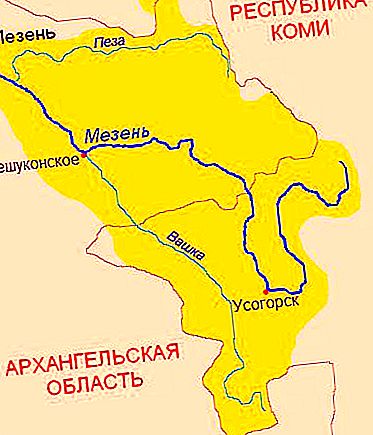
In the European North of Russia, it, together with Pechora and the Northern Dvina, is one of the largest rivers. Its uniqueness lies in the fact that in the upper reaches and closer to the central part, Mezen flows south, and only in the territory of the Arkhangelsk region unfolds and rushes to the White Sea.
In inaccessible places there is always good fishing and hunting.
The impressive size of the river basin is 78, 000 square kilometers. Mezen flows through the territory of the Arkhangelsk region and the Komi Republic, in the sparsely populated area of which on the slopes of the Timan Ridge, at an altitude of 370 meters above sea level, among the marshes and rocks of the Chetlas stone, is the source of the Mezen river. Given the height of the total fall (370 m) and length, it can be stated that the river slope is 0.383%. The name of this aquatic artery does not have many variants of origin - from the Finno-Ugric language it is translated as a place of successful fishing and fishing.
Hard to reach places
As noted above, the territories through which the Mezen River flows were deserted in ancient times. They are not populated even today - settlements appeared here only in the second half of the 14th century.
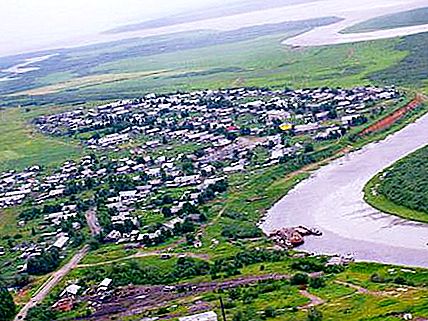
The first, as a point on the commercial "cross-stone" (from the Pechora basin "through the stone", that is, the Ural Mountains) paths to Siberia, the village of Lampozhnia is mentioned. And this is explained not only by the harsh northern climate, but rather by the fact that the area of the river basin is fenced off from the rest of the world from the west by the powerful Northern Dvina, and from the south by its largest tributary - Vychegda. Out of 8 dozens of small settlements located from source to mouth, more or less large cities are Usogorsk and Mezen, as well as the village of Leshukonskoye.
Message paths
Ways of communication with this region, as well as between its settlements, leave much to be desired. The railway line runs to the city of Usogorsk from the Kotlas-Vorkuta highway. The Mezen river itself is navigable in almost its entire course, and the section from the village of Koslan to the village of White Nose is included in the list of navigable water arteries of the country. Powerful, but not year-round ferry crossings exist on the river and its tributaries. They stop their work for quite long periods of the off-season, mainly from the month of October until January, that is, until the moment when ice crossings are established on the river.
Air and car communication
Airplanes of local airlines fly to the city of Mezen, located at the confluence of the river of the same name in the Mezen Bay of the White Sea. Vaskovo Airport, from where planes fly to Mezen, is located near Arkhangelsk. The only highway connecting the huge northern region with the rest of the world is the Arkhangelsk highway - the city of Mezen, passing through the settlements of Belgorod, Pinega, Sovpolye.

Asphalt pavement exists only on a small initial section of the Arkhangelsk-Belgorod highway. Further down to the final destination there is a dirt road, sometimes of very poor quality.
Tributaries
The region where the Mezen River is located is rich in water resources - 15187 tributaries replenish this water artery. The main tributaries include 103 rivers, 53 of which are left, and, accordingly, 50 are right. The largest include Mezenskaya Tansy and Sula, Kyma and Peza, Vashka and Pyssa, Us, Bolshaya Loptyuga and Irva. The longest of them, Vashka, stretches for 605 km, the shortest, Us - for 102. These are the main tributaries of the Mezen River. One of them is interesting for its bifurcation, or bifurcation of the channel. Mezenskaya Tansy (236 km), due to this phenomenon, flows into both Pechora and Mezen, and connects the latter with the Pechora water basin.
Natural watershed
The soils of the Mezen basin are mainly podzolic and marsh (the bogging of the entire territory is 17%). There are sands here that run in a wide strip from the slopes of Timan to the Mezen watershed and its tributary Vashka. And on Timan itself, humus-carbonate soils are found. The sights of this region are amazingly shaped rock outcrops.
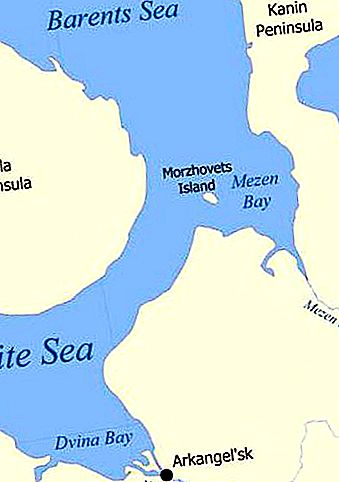
The Timan Ridge, on which the Mezen River originates, is the natural watershed of the entire Dvina-Pechora basin. It stretches for 900 kilometers, the highest point is at the level of 471 meters. One of its spurs blocks the path of Mezen in its middle course, due to which the river makes a 500-kilometer hook. Starting from the source, which is located on a plateau-like hill Chetlas Stone, covered with fir and spruce and rising 463 m above sea level, the river is a fast mountain stream with rapids and rifts. And as it should be a typical mountain river, the shores of Mezen are high and rocky, and the width varies from 8 to 15 meters. Because of the spurs of the Timan Ridge, the river winds all the time, changes direction.
East Bay
In the lower reaches, its width sometimes reaches 1 kilometer, and low coasts are often marshy. It was indicated above where the Mezen River flows into the Mezen Bay, which is one of the four largest bays of the White Sea, such as Kandalaksha Bay, Dvinskaya and Onega Bay. The Mezen Bay lies south of the Kanin Peninsula, its length is 105 meters, its width is 97, and its depth varies from 5 to 25 meters.
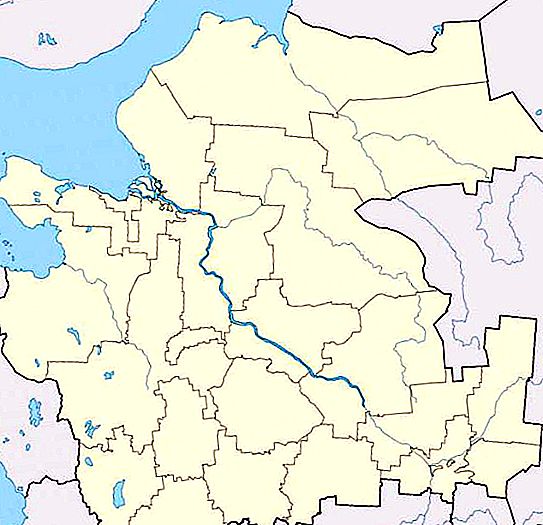
In addition to the water artery, after which the lip is named, the Kula River flows into it. This easternmost bay of the White Sea has the most opaque water, since the Mezen River is quite muddy, although due to the sparsely populated coasts, the anthropogenic factor is almost absent here, and Mezen is recognized as the cleanest in Europe among the large rivers flowing directly into the sea.
So long and so different
All the while looping, Mezen flows through three natural subzones - the middle taiga, northern taiga and forest-tundra alternate along the entire route.
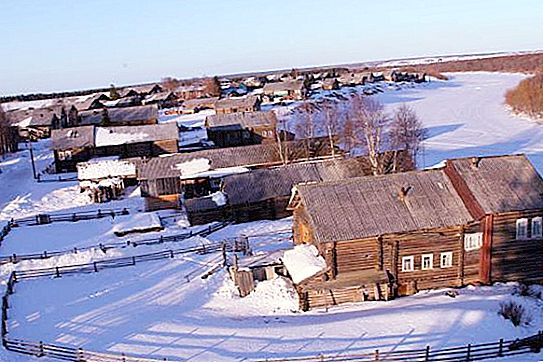
The forest basin of the river - 80% of its territory is covered by green spaces, mostly coniferous forests. The richness and diversity of flora and fauna is explained by the long length of the river - magnificent tall trunk coniferous forests grow in the south, meager communities of mosses and lichens grow in the north, and a total of 1300 plant species grow in the Mezen basin valley (without lichens).
Rich wildlife
There are more than 400 species of vertebrates in this region; there are even more invertebrates. A wild subspecies of a reindeer is listed in the Red Book. The fox is depicted in the center of the coat of arms of the Mezen district. Arctic fox, wolverine, wolf, white hare, muskrat, squirrels - these are the most numerous representatives of the fauna of the Mezen basin. A huge number of birds in this region allows fishing for black grouse, capercaillie, hazel grouse, ducks and geese. The following species of birds are under protection - eider and swan, falcons (gyrfalcon and peregrine falcon), white-chested geese and osprey, golden eagle and white-tailed eagle.
Numerous inhabitants of the river
The water animals of the Mezen River are enormously diverse. Here, salmon or Atlantic salmon, whitefish and nelma are found in large numbers. Naturally, despite the enormous availability of other fish species, valuable species suffer mainly from uncontrolled illegal capture. So, salmon stocks have significantly decreased. This is to blame for both the dysfunctional social situation (lack of well-paid work) in villages scattered along the shores of the Mezen, and the unreasonable deforestation in the territory of the Udorsky municipality. These felling led to a change in surface runoff, which, in turn, entailed sanding and overgrowing of the channel by aquatic vegetation. As a result, wintering pits disappear in which Atlantic salmon spawn. All of the above leads to an increase in the order of predators in the river - pike and perch, which also reduces the amount of salmon. Other fish species that live in Mezen in sufficient quantities include European grayling and roach. There are a lot of ide and bream, dace and burbot, river flounder and lamprey. All types of fish, including pike predators and perch, are objects of both legal and unauthorized capture.




